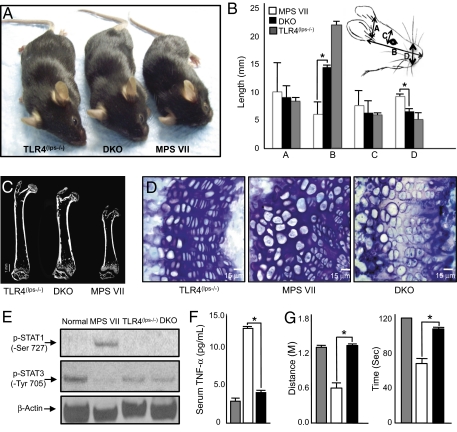Fig. 3.
(A) MPS VII and TLR4(lps−/−) mice were crossed to produce a double-mutant (DKO) strain (MPS VII/TLR4(lps−/−)). Note the dramatic size difference between MPS VII and DKO mice. Shown are representative 5-month-old TLR4(lps−/−), DKO, and MPS VII male mice. (B) Skull measurements, including width (A), length (B), inner canthal distance (C), and nose widths (D), were taken of age- and gender-matched TLR4(lps−/−), DKO, and MPS VII male mice (n = 6). TLR4(lps−/−) mice had skull measurements that were equivalent to normal. A significant increase in skull length and reduction in width were observed in the DKO mice compared with the MPS VII mice. *P < 0.001. (C) Micro-CT analysis was performed on femora from TLR4(lps−/−), DKO, and MPS VII male mice (n = 6). A representative image is shown, revealing that the bones were significantly longer in DKO vs. MPS VII mice. (D) Representative images of the growth plates from TLR4(lps−/−), MPS VII, and DKO mice. Note that the growth plates were thinner in DKO vs. MPS VII mice and that the columns were more organized. (Scale bar: 15 μm.) (E) Levels of p-STAT1-Ser727 (90 kDa) and p-STAT3-Tyr705 (90 kDa) were analyzed by Western blotting in normal, MPS VII, TLR4(lps−/−), and DKO mice. β-Actin was used as a loading control (46 kDa). MPS VII mice had elevated p-STAT1-Ser727 and reduced p-STAT3-Tyr705; these were corrected in the DKO mice. (F) TNF-α serum levels were analyzed by ELISA in 5-month-old TLR4(lps−/−) (gray bar), MPS VII (white bar), and DKO (black bar) mice (n = 6). Significantly elevated TNF-α levels were evident in the MPS VII mice, which were normalized in the DKO mice. (G) Male 5-month-old TLR4(lps−/−) (gray bar), MPS VII (white bar), and DKO (black bar) mice were placed on an accelerating rotarod to assess coordination and mobility (n = 6). The MPS VII mice could not complete the task and fell off between 54 (0.38 m) and 75 (0.70 m) sec after initiating the run. In contrast, the DKO mice completed the 120-sec (1.4 m) task, equivalent to the control TLR4(lps−/−) mice. *P < 0.001.

